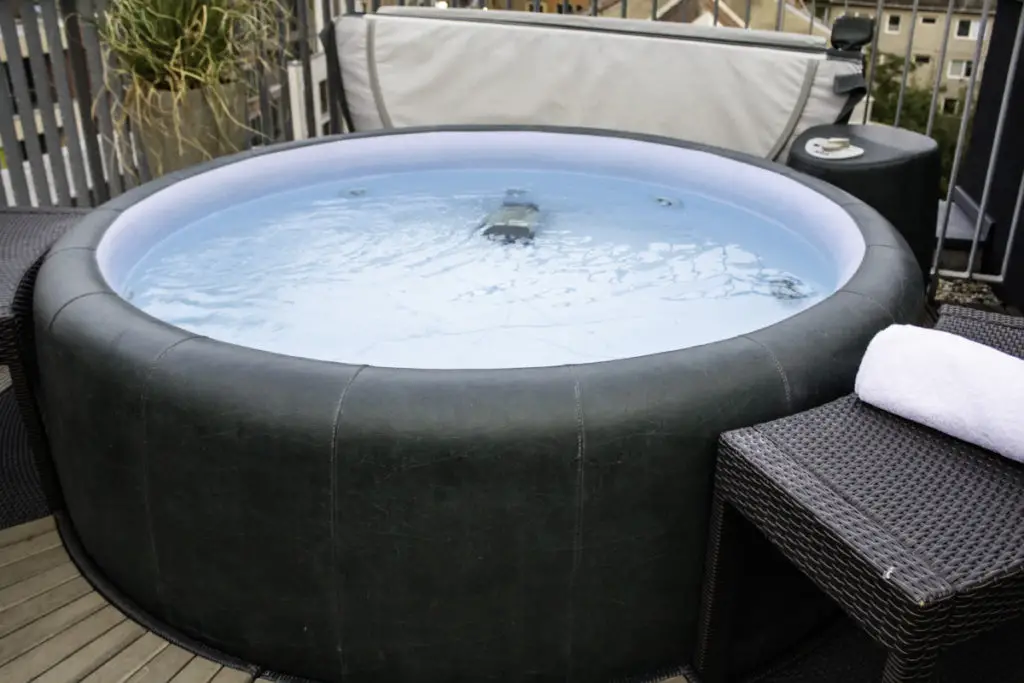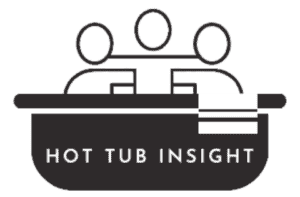This post contains affiliate links.

Hot tubs are great, but they can be expensive and aren’t really as portable as their name makes them sound. In comes inflatable hot tubs, if you are short on space, want something more portable, or want to keep more money in your wallet, then they might just be what you are looking for. You may be asking yourself what you are giving up in the process. Do inflatable hot tubs get as hot as a normal portable hot tub?
Inflatable hot tubs can get as hot as 104oF. In fact, all commercially available hot tubs are limited to a maximum temperature of 104oF for the bather’s safety. The maximum temperature may vary based on ambient temperature, how long it is in use with the cover off, and if you are running the jets or blower.
There are other factors to consider when determining how an inflatable hot tub will perform in your particular situation. Let’s get into the details.
How To Maximize Your Hot Tub’s Heat And Performance?
We know that an inflatable hot tub can reach the same maximum temperature of 104oF as non-inflatable hot tubs. There has to be a catch, otherwise, why wouldn’t everyone who just cares about heat performance purchase an inflatable hot tub? There is, and it can be a deal-breaker depending on where you live. I’ll break it down below.
Ambient Temperature
As the name suggests, an inflatable hot tub gets its volume and ridged structure from air, much like an air mattress. While this makes the inflatable hot tub great in some ways, like the ease of setup, portability, cost. It does not provide protection from the cold.
Water is a great natural thermal reservoir which means it likes to hold on to heat. This is why the Great Lakes region of the US gets lake effect snow in the winter. The lake water stays warm and provides a source of moisture and energy that is picked up by the cold winter wind as it blows across the water surface.
Your inflatable hot tub does not have nearly the amount of volume as a Great Lake. For example, Lake Superior has a volume of 2,900 cubic miles of water. That is 3.1933 x 10^15 gallons. But even a couple hundred gallons of water has a pretty good thermal mass.
What does this mean for your inflatable hot tub? It means you can still use it in cooler temperatures to a point. Most manufacturers warn against using an inflatable hot tub when the ambient air temperature drops below 40F.
Some of this is due to the materials used in the hot tub shell which may become brittle at cold temperatures and lose structural strength. Imagine a dam breaking and you left sitting on the cold wet ground in your swimsuit.
The main reason for this limitation is that the heater simply isn’t capable of heating the water faster than it is losing heat at these temperatures. If the air temperature is below 32F, the hot tub will eventually freeze. Not great unless you are looking for an ice rink.
Non-inflatable hot tubs have insulation, larger heaters, and an insulated cover to keep them warm in cold temperatures. I have used mine in single-digit temperatures. The trip to and from the hot tub was a bit chilly, but the water was a relaxing 102F. Don’t do that in an inflatable hot tub, please!
Cover Performance
The hot tub cover that comes with an inflatable hot tub is usually pretty thin. Their main purpose is to keep unwanted things out of the hot tub when it is not in use. Dirt, leaves, bugs, and your neighbor’s teenagers all want to relax in the warm bubbly water when you are away.
The cover does also provide some thermal benefit to the hot tub meaning the hot tub will heat faster and run more efficiently with the cover securely in place. But think of it more like wearing a baseball cap when shoveling the snow off your driveway. Sure it does something, but you would rather be wearing your winter hat.
In summary, make sure you keep the cover on when the hot tub is not in use. Your electric bill will thank you and your filter will too.
Pump and Heater Power Limitations
Before we talk about inflatable hot tub power limitations, we need to get a few things straight.
The first thing is first, most people are used to seeing the unit kWh on their electric bill. A kWh is a measurement of kW over time. For example, a 1kW space heater will use 1kWh for every hour it is continuously operated. This means if you heat your room for 10 hours, it will use 10kWh of electricity in the process.
A standard home in the US will have a 120V and 240V source. Most items in your home will run off of the 120V source, but larger appliances like a clothes dryer and electric oven will run off of the 240V source. The reason for this is your clothes dryer uses more power than your toaster. Without getting too heavy into the math, the higher voltage means the appliance will draw less current at its power level than if it was running at a lower voltage.
Less current is good because it means the wire gauge of the wire in the wall can be smaller. I bet you didn’t think you would be getting a lesson in electrical engineering reading this article.
Inflatable hot tubs generally run off of a standard 120V outlet in the US. In the hot tub industry, this is called “Plug and Play”.
A typical inflatable hot tub heater will be power rated around 1.5kW. By comparison, if you have an electric hot water tank that runs off of 240V it will generally have a 4.5kW heater. The heater size is limited by the amount of current that can be drawn from the wall.
The standard American residential 120V electrical circuit is rated at 15A. This means the maximum power that can be pulled from that circuit is 1.8kW. So an inflatable hot tub on that circuit will use 1.5kW of the capacity for the heater leaving just 300W of a buffer. If the 15A circuit rating is exceeded the circuit breaker will trip and your hot tub will turn off.
In general, leaving a buffer is a good thing, because nobody wants to keep tripping the breaker.
What does this all mean? There are going to be limitations on how many functions and features of the hot tub can operate at the same time. Usually, this means you cannot run both the heater and the main pump/blower at the same time.
Let me explain why. A higher power-rated heater will heat the hot tub faster. Therefore manufacturers generally use the highest power rated heater possible, that will fit within the restrictions mentioned above.
The downside to this is that maximizing heating performance will use all the available power from the wall circuit leaving very little power for anything else to run. So if the hot tub controller ran the heater at max power and then turned on the blower, it would pull too much current and trip the circuit breaker.
Therefore the hot tub controller will limit what features can run to ensure that the maximum power drawn from the wall circuit is under 15A.
If you are sitting in your hot tub with the blower running, it will not maintain temperature. The rate of decline will depend on the temperature of the outside air.
Insulation
In a typical well-built normal hot tub, the cabinet surrounding the hot tub shell will be filled with a thick layer of insulation. The insulation helps prevent heat loss which makes the hot tub run more efficiently. This is what allows a normal hot tub to run in the winter.
An inflatable hot tub has very little if any insulation, other than the small amount the material of the shell and the air gap between the inside and outside wall creates. Because of this, an inflatable hot tub runs pretty inefficiently. This is why they have outside temperature restrictions.
As the outside temperature drops, the temperature difference between the warm water inside the hot tub and the cold air outside the hot tub will increase. This also increases the rate at which the heat will transfer from the water to the outside air. If there isn’t anything in between to slow this rate of transfer then the hot tub will not stay hot for very long.
Hopefully, you are starting to see the full picture.
Can You Use An Inflatable Hot Tub In A Cold Climate?
It is possible to use an inflatable hot tub in a cold climate, but you will likely need to find a way to add additional insulation around the hot tub to increase its efficiency. That way as the air temperature drops the water will lose heat slower increasing the outside temperature range that the hot tub heater can keep up.
Remember, you should always follow the manufacturer’s warnings and guidelines when operating your inflatable hot tub. This means operating the hot tub outside of the manufacturer’s specification is done so at your own risk and will likely void the warranty.
If it snows during the winter where you live, my recommendation would be to skip the inflatable hot tub. If you want one, use it from late spring to early fall only. Winter hot tubbing is best left to a normal hot tub.
The Inflatable Hot Tub I Recommend
I do not take product recommendations lightly and do not list any product that I would not use myself.
Intex PureSpa Greywood Deluxe 4 or 6 Person Spa

Intex is a well-known brand for inflatable products. They produce a few variations of an inflatable hot tub, but their PureSpa Deluxe line is their flagship and best product line you can buy. It is easy to set up with a built-in inflation system and easy to connect components. It can be purchased in two sizes:
| Dimensions | Intex PureSpa Deluxe 4 Person | Intex PurSpa Deluxe 6 Person |
| Volume | 210 gallons | 290 gallons |
| Interior Diameter | 57 in | 65 in |
| Exterior Diameter | 77 in | 85 in |
| Depth | 28 in | 28 in |
Product: Intex PureSpa Deluxe 4 Person Version
Product: Intex PureSpa Deluxe 6 Person Version
Why Do I Like This Hot Tub?
- Comes in 2 sizes (4 person or 6 person)
- Includes 2 headrests, a cover, a ground pad, extra filters, and a chlorine dispenser
- Has a lighting package
- Good size heater and pump for the price
What Don’t I Like About This Hot Tub?
- The 6 person version is too big for Intex insulated cover add-on
- The 6 person version has the same size blower, pump, and heater as the 4 person


